Impact of Packaging Methods on Physicochemical Properties, Flavor Profile, and Microbial Community in Low-Temperature Stored Mianning Ham
Abstract
1. Introduction
2. Materials and Methods
2.1. Sample Preparation and Sampling
2.2. Measurement of Physical and Chemical Properties
2.3. Determination of Flavor Substances
2.4. High-Throughput Sequencing
2.5. Statistical Analysis
3. Results and Analysis
3.1. Analysis of Physical and Chemical Results
Correlation Analysis of Physical and Chemical Properties
3.2. Analysis of Volatile Flavor Substances
3.3. Analysis of Microbial Diversity
4. Correlation Analysis Between Microorganisms and Key Flavor Substances
5. Conclusions
Supplementary Materials
Author Contributions
Funding
Institutional Review Board Statement
Informed Consent Statement
Data Availability Statement
Conflicts of Interest
References
- Huang, Q.; Xie, R.; Wu, X.; Zhao, K.; Li, H.; Tang, H.; Du, H.; Peng, X.; Chen, L.; Zhang, J. Insights into the protein differentiation mechanism between Jinhua fatty ham and lean ham through Label-Free proteomics. Foods 2023, 12, 4348. [Google Scholar] [CrossRef] [PubMed]
- Petrova, I.; Aasen, I.M.; Rustad, T.; Eikevik, T.M. Manufacture of dry-cured ham: A review. Part 1. Biochemical changes during the technological process. Eur. Food Res. Technol. 2015, 241, 587–599. [Google Scholar] [CrossRef]
- Huang, Y.; Wang, Z.; Gan, L.; Zhang, J.; Wang, W.; Ji, L.; Chen, L. Study on the changes and correlation of microorganisms and flavor in different processing stages of Mianning ham. Foods 2024, 13, 2587. [Google Scholar] [CrossRef]
- Zhang, J.; Zhao, K.; Li, H.; Li, S.; Xu, W.; Chen, L.; Xie, J.; Tang, H. Physicochemical property, volatile flavor quality, and microbial community composition of Jinhua fatty ham and lean ham: A comparative study. Front. Microbiol. 2023, 14, 1124770. [Google Scholar] [CrossRef]
- Chen, L.; Wang, Z.; Ji, L.; Zhang, J.; Zhao, Z.; Zhang, R.; Bai, T.; Hou, B.; Wang, W. Flavor composition and microbial community structure of Mianning ham. Front. Microbiol. 2021, 11, 623775. [Google Scholar] [CrossRef]
- Li, F.; Feng, X.; Zhang, D.; Li, C.; Xu, X.; Zhou, G.; Liu, Y. Physical properties, compositions and volatile profiles of Chinese dry-cured hams from different regions. J. Food Meas. Charact. 2020, 14, 492–504. [Google Scholar] [CrossRef]
- Li, W.; Chen, Y.P.; Blank, I.; Li, F.; Li, C.; Liu, Y. GC × GC-ToF-MS and GC-IMS based volatile profile characterization of the Chinese dry-cured hams from different regions. Food Res. Int. 2021, 142, 110222. [Google Scholar] [CrossRef]
- Zhu, Y.; Wang, W.; Zhang, Y.; Li, M.; Zhang, J.; Ji, L.; Zhao, Z.; Zhang, R.; Chen, L. Characterization of quality properties in spoiled Mianning ham. Foods 2022, 11, 1713. [Google Scholar] [CrossRef]
- Huan, Y.; Zhou, G.; Zhao, G.; Xu, X.; Peng, Z. Changes in flavor compounds of dry-cured Chinese Jinhua ham during processing. Meat Sci. 2005, 71, 291–299. [Google Scholar] [CrossRef]
- Li, G.; Li, S.; Wen, Y.; Yang, J.; Wang, P.; Wang, H.; Cui, Y.; Wu, W.; Li, L.; Liu, Z. Correlation between the characteristic flavour and microbial community of Xuanwei ham after ripening. Fermentation 2024, 10, 392. [Google Scholar] [CrossRef]
- Lozano-Ojalvo, D.; Rodriguez, A.; Cordero, M.; Bernaldez, V.; Reyes-Prieto, M.; Cordoba, J.J. Characterisation and detection of spoilage mould responsible for black spot in dry-cured fermented sausages. Meat Sci. 2015, 100, 283–290. [Google Scholar] [CrossRef] [PubMed]
- Morales, R.; Guerrero, L.; Aguiar, A.P.S.; Guardia, M.D.; Gou, P. Factors affecting dry-cured ham consumer acceptability. Meat Sci. 2013, 95, 652–657. [Google Scholar] [CrossRef] [PubMed]
- Cilla, I.; Martínez, L.; Beltrán, J.A.; Roncalés, P. Factors affecting acceptability of dry-cured ham throughout extended maturation under “Bodega” conditions. Meat Sci. 2005, 69, 789–795. [Google Scholar] [CrossRef] [PubMed]
- Cachaldora, A.; García, G.; Lorenzo, J.M.; García-Fontán, M.C. Effect of modified atmosphere and vacuum packaging on some quality characteristics and the shelf-life of “Morcilla”, a typical cooked blood sausage. Meat Sci. 2013, 93, 220–225. [Google Scholar] [CrossRef]
- Pereira, J.A.; Dionísio, L.; Patarata, L.; Matos, T.J.S. Effect of packaging technology on microbiological and sensory quality of a cooked blood sausage, morcela de Arroz, from Monchique region of Portugal. Meat Sci. 2015, 101, 33–41. [Google Scholar] [CrossRef]
- Parra, V.; Viguera, J.; Sanchez, J.; Peinado, J.; Esparrago, F.; Gutierrez, J.I.; Andres, A.I. Modified atmosphere packaging and vacuum packaging for long period chilled storage of dry-cured Iberian ham. Meat Sci. 2010, 84, 760–768. [Google Scholar] [CrossRef]
- Ortiz, A.; Tejerina, D.; Díaz-Caro, C.; Elghannam, A.; García-Torres, S.; Mesías, F.J.; Trujillo, J.; Crespo-Cebada, E. Is packaging affecting consumers’ preferences for meat products? A study of modified atmosphere packaging and vacuum packaging in Iberian dry-cured ham. J. Sens. Stud. 2020, 35, e12575. [Google Scholar] [CrossRef]
- Zhao, S.; Wu, J.; Guo, Z.; Wang, D.; Chen, J.; Liu, Q.; Ding, C.; Guo, L.; Tao, T. Magnetic field technology in improving the quality of food refrigeration and freezing: Mechanisms, applications, and challenges. J. Stored Prod. Res. 2024, 106, 102254. [Google Scholar] [CrossRef]
- Zeng, Q.; Ji, L.; Wang, W.; Zhang, J.; Bai, T.; Gan, L.; Chen, L. Comparative studies on physicochemical properties, volatile flavor substances and microbial community of Mianning ham at different altitudes. Front. Microbiol. 2025, 16, 1536749. [Google Scholar] [CrossRef]
- Wang, X.; Zhang, Y.; Ren, H.; Zhan, Y. Comparison of bacterial diversity profiles and microbial safety assessment of salami, Chinese dry-cured sausage and Chinese smoked cured sausage by high-throughput sequencing. LWT 2018, 90, 108–115. [Google Scholar] [CrossRef]
- Liu, W.; Zhang, Y.; Yang, Q.; Fan, S.; Tian, Y.; Zhang, W. Detection of ochratoxin A in food by an electrochemical aptamer biosensor based on chain substitution amplification. Chin. J. Food 2024, 24, 232–241. [Google Scholar] [CrossRef]
- Guo, M.; Wu, F.; Hao, G.; Qi, Q.; Li, R.; Li, N.; Wei, L.; Chai, T. Bacillus subtilis improves immunity and disease resistance in rabbits. Front. Immunol. 2017, 8, 354. [Google Scholar] [CrossRef] [PubMed]
- Piotrowska-Cyplik, A.; Myszka, K.; Czarny, J.; Ratajczak, K.; Kowalski, R.; Bieganska-Marecik, R.; Staninska-Pięta, J.; Nowak, J.; Cyplik, P. Characterization of specific spoilage organisms (SSOs) in vacuum-packed ham by culture-plating techniques and MiSeq next-generation sequencing technologies. J. Sci. Food Agric. 2017, 97, 659–668. [Google Scholar] [CrossRef] [PubMed]
- Shan, L.; Li, Y.; Zheng, S.; Wei, Y.; Shang, Y. Analysis of the bacterial floral structure and diversity of Xuanwei ham by 16S rDNA sequencing. J. Food Saf. 2020, 40, e12800. [Google Scholar] [CrossRef]
- Magoč, T.; Salzberg, S.L. FLASH: Fast length adjustment of short reads to improve genome assemblies. Bioinformatics 2011, 27, 2957–2963. [Google Scholar] [CrossRef]
- Puente-Sánchez, F.; Aguirre, J.; Parro, V. A novel conceptual approach to read-filtering in high-throughput amplicon sequencing studies. Nucleic Acids Res. 2016, 44, e40. [Google Scholar] [CrossRef]
- DeSantis, T.Z.; Hugenholtz, P.; Larsen, N.; Rojas, M.; Brodie, E.L.; Keller, K.; Huber, T.; Dalevi, D.; Hu, P.; Andersen, G.L. Greengenes, a chimera-checked 16S rRNA gene database and workbench compatible with ARB. Appl. Environ. Microbiol. 2006, 72, 5069–5072. [Google Scholar] [CrossRef]
- Edgar, R.C. UPARSE: Highly accurate OTU sequences from microbial amplicon reads. Nat. Methods 2013, 10, 996–998. [Google Scholar] [CrossRef]
- Lu, N.; Qiao, Y.; An, P.; Luo, J.; Bi, C.; Li, M.; Lu, Z.; Tu, J. Exploration of whole genome amplification generated chimeric sequences in long-read sequencing data. Brief. Bioinform. 2023, 24, bbad275. [Google Scholar] [CrossRef]
- Edgar, R.C.; Haas, B.J.; Clemente, J.C.; Quince, C.; Knight, R. UCHIME improves sensitivity and speed of chimera detection. Bioinformatics 2011, 27, 2194–2200. [Google Scholar] [CrossRef]
- Pruesse, E.; Quast, C.; Knittel, K.; Fuchs, B.M.; Ludwig, W.; Peplies, J.; Glöckner, F.O. SILVA: A comprehensive online resource for quality checked and aligned ribosomal RNA sequence data compatible with ARB. Nucleic Acids Res. 2007, 35, 7188–7196. [Google Scholar] [CrossRef] [PubMed]
- Wang, Q.; Garrity, G.M.; Tiedje, J.M.; Cole, J.R. Naive Bayesian classifier for rapid assignment of rRNA sequences into the new bacterial taxonomy. Appl. Environ. Microbiol. 2007, 73, 5261–5267. [Google Scholar] [CrossRef] [PubMed]
- Jin, S.-K.; Choi, J.-S. Effect of packaging methods on quality characteristics of fermented dry-cured hams during cold storage at 4 °C. J. Food Meas. Charact. 2017, 11, 2052–2060. [Google Scholar] [CrossRef]
- Olaimat, A.N.; Osaili, T.M.; Al-Holy, M.A.; Al-Nabulsi, A.A.; Obaid, R.S.; Alaboudi, A.R.; Ayyash, M.; Holley, R. Microbial safety of oily, low water activity food products: A review. Food Microbiol. 2020, 92, 103571. [Google Scholar] [CrossRef]
- Ameer, A.; Seleshe, S.; Kang, S.N. Effect of modified atmosphere packaging varying in CO2 and N2 composition on quality characteristics of dry fermented sausage during refrigeration storage. Food Sci. Anim. Resour. 2022, 42, 639–654. [Google Scholar] [CrossRef]
- Dominguez, R.; Pateiro, M.; Munekata, P.E.S.; Zhang, W.; Garcia-Oliveira, P.; Carpena, M.; Prieto, M.A.; Bohrer, B.; Lorenzo, J.M. Protein oxidation in muscle foods: A comprehensive review. Antioxidants 2022, 11, 60. [Google Scholar] [CrossRef]
- Zhou, F.; Zhao, M.; Su, G.; Cui, C.; Sun, W. Gelation of salted myofibrillar protein under malondialdehyde-induced oxidative stress. Food Hydrocoll. 2014, 40, 153–162. [Google Scholar] [CrossRef]
- Ma, Z.; Zhang, Y.; Hui, T.; Wang, W.; Xu, W.; Qian, J.; Peng, Z. Changes in physicochemical properties of low-sodium traditional Jinhua ham during processing. Food Ind. Sci. Technol. 2016, 37, 118–123+127. [Google Scholar] [CrossRef]
- Sayadi, M.; Mojaddar Langroodi, A.; Amiri, S.; Radi, M. Effect of nanocomposite alginate-based film incorporated with cumin essential oil and TiO2 nanoparticles on chemical, microbial, and sensory properties of fresh meat/beef. Food Sci. Nutr. 2022, 10, 1401–1413. [Google Scholar] [CrossRef]
- Deuchande, T.; Fundo, J.F.; Pintado, M.E.; Amaro, A.L. Protocatechuic acid as an inhibitor of lipid oxidation in meat. Meat Sci. 2024, 213, 109519. [Google Scholar] [CrossRef]
- Li, C.; Taniguchi, I.; Mulchandani, A. Redox properties of engineered ruthenium myoglobin. Bioelectrochemistry 2009, 75, 182–188. [Google Scholar] [CrossRef] [PubMed]
- Anandh, M.A. Shelf life of boiled restructured buffalo meat rolls in refrigerated storage under vacuum packaging condition. J. Appl. Anim. Res. 2015, 43, 318–323. [Google Scholar] [CrossRef]
- McMillin, K.W. Advancements in meat packaging. Meat Sci. 2017, 132, 153–162. [Google Scholar] [CrossRef] [PubMed]
- Armenteros, M.; Aristoy, M.-C.; Barat, J.M.; Toldrá, F. Biochemical and sensory changes in dry-cured ham salted with partial replacements of NaCl by other Chloride salts. Meat Sci. 2012, 90, 361–367. [Google Scholar] [CrossRef]
- Gilles, G. Dry cured ham quality as related to lipid quality of raw material and lipid changes during processing: A review. Grasas Aceites 2009, 60, 297–307. [Google Scholar] [CrossRef]
- Al-Areimi, M.; Al-Habsi, N.; Al-Jufaili, S.M.; Rahman, M.S. State diagram of freeze-dried sardines (Sardinella longiceps, Valenciennes). J. Food Eng. 2024, 379, 112107. [Google Scholar] [CrossRef]
- Muhlisin; Kang, S.M.; Choi, W.H.; Lee, K.T.; Cheong, S.H.; Lee, S.K. The effect of modified atmosphere packaging and addition of rosemary extract, sodium acetate and calcium lactate mixture on the quality of pre-cooked hamburger patties during refrigerated storage. Asian-Australas. J. Anim. Sci. 2013, 26, 134–142. [Google Scholar] [CrossRef][Green Version]
- Yim, D.-G.; Jung, J.-H.; Ali, M.M.; Nam, K.-C. Comparison of physicochemical traits of dry-cured ham from purebred Berkshire and crossbred Landrace × Yorkshire × Duroc (LYD) pigs. J. Anim. Sci. Technol. 2019, 61, 35–40. [Google Scholar] [CrossRef]
- Lee, S.H.; Choe, J.H.; Choi, Y.M.; Jung, K.C.; Rhee, M.S.; Hong, K.C.; Lee, S.K.; Ryu, Y.C.; Kim, B.C. The influence of pork quality traits and muscle fiber characteristics on the eating quality of pork from various breeds. Meat Sci. 2012, 90, 284–291. [Google Scholar] [CrossRef]
- Marušić, N.; Petrović, M.; Vidaček, S.; Petrak, T.; Medić, H. Characterization of traditional Istrian dry-cured ham by means of physical and chemical analyses and volatile compounds. Meat Sci. 2011, 88, 786–790. [Google Scholar] [CrossRef]
- Gómez, M.; Cachaldora, A.; Fonseca, S.; Domínguez, R.; Carballo, J.; Franco, I. Biochemical, oxidative, and lipolytic changes during vacuum-packed storage of dry-cured loin: Effect of chestnuts intake by Celta Pigs. J. Food Qual. 2018, 2018, 7690501. [Google Scholar] [CrossRef]
- Grossi, A.; Søltoft-Jensen, J.; Knudsen, J.C.; Christensen, M.; Orlien, V. Synergistic cooperation of high pressure and carrot dietary fibre on texture and colour of pork sausages. Meat Sci. 2011, 89, 195–201. [Google Scholar] [CrossRef] [PubMed]
- Lee, K.T. Quality and safety aspects of meat products as affected by various physical manipulations of packaging materials. Meat Sci. 2010, 86, 138–150. [Google Scholar] [CrossRef]
- Amna, T.; Yang, J.; Ryu, K.-S.; Hwang, I.H. Electrospun antimicrobial hybrid mats: Innovative packaging material for meat and meat-products. J. Food Sci. Technol. 2015, 52, 4600–4606. [Google Scholar] [CrossRef]
- Zhao, L.; Jin, Y.; Ma, C.; Song, H.; Li, H.; Wang, Z.; Xiao, S. Physico-chemical characteristics and free fatty acid composition of dry fermented mutton sausages as affected by the use of various combinations of starter cultures and spices. Meat Sci. 2011, 88, 761–766. [Google Scholar] [CrossRef]
- Li, B.; Xu, Y.; Li, J.; Niu, S.; Wang, C.; Zhang, N.; Yang, M.; Zhou, K.; Chen, S.; He, L.; et al. Effect of oxidized lipids stored under different temperatures on muscle protein oxidation in Sichuan-Style sausages during ripening. Meat Sci. 2019, 147, 144–154. [Google Scholar] [CrossRef]
- Holck, A.L.; Axelsson, L.; Rode, T.M.; Høy, M.; Måge, I.; Alvseike, O.; L’Abée-Lund, T.M.; Omer, M.K.; Granum, P.E.; Heir, E. Reduction of verotoxigenic Escherichia coli in production of fermented sausages. Meat Sci. 2011, 89, 286–295. [Google Scholar] [CrossRef]
- Dučić, M.S.; Markov, S.L. Overview of treatments for improving the microbial safety of dry fermented sausages. J. Food Saf. Food Qual.-Arch. Für Leb. 2022, 73, 33. [Google Scholar] [CrossRef]
- Flores, M.; Corral, S.; Cano-García, L.; Salvador, A.; Belloch, C. Yeast strains as potential aroma enhancers in dry fermented sausages. Int. J. Food Microbiol. 2015, 212, 16–24. [Google Scholar] [CrossRef]
- Hwang, J.; Kim, Y.; Seo, Y.; Sung, M.; Oh, J.; Yoon, Y. Effect of starter cultures on quality of fermented sausages. Food Sci. Anim. Resour. 2023, 43, 1–9. [Google Scholar] [CrossRef]
- Zhou, Y.; Wang, Y.; Pan, Q.; Wang, X.; Li, P.; Cai, K.; Chen, C. Effect of salt mixture on flavor of reduced-sodium restructured bacon with ultrasound treatment. Food Sci. Nutr. 2020, 8, 3857–3871. [Google Scholar] [CrossRef] [PubMed]
- Wang, W.; Zhu, Y.; Wang, W.; Zhang, J.; He, D.; Ji, L.; Chen, L. Influence of Penicillium lanosum and Staphylococcus equorum on microbial diversity and flavor of Mianning hams. Foods 2024, 13, 2494. [Google Scholar] [CrossRef] [PubMed]
- Mu, Y.; Su, W.; Mu, Y.; Jiang, L. Combined application of high-throughput sequencing and metabolomics reveals metabolically active microorganisms during Panxian ham processing. Front. Microbiol. 2020, 10, 3012. [Google Scholar] [CrossRef] [PubMed]
- Yu, H.; Zhang, S.; Liu, X.; Lei, Y.; Wei, M.; Liu, Y.; Yang, X.; Xie, P.; Sun, B. Comparison of physiochemical attributes, microbial community, and flavor profile of beef aged at different temperatures. Front. Microbiol. 2022, 13, 1091486. [Google Scholar] [CrossRef]
- Petricevic, S.; Radovcic, N.M.; Lukic, K.; Listes, E.; Medic, H. Differentiation of dry-cured hams from different processing methods by means of volatile compounds, physico-chemical and sensory analysis. Meat Sci. 2018, 137, 217–227. [Google Scholar] [CrossRef]
- Yang, G.; Zhang, J.; Dai, R.; Ma, X.; Huang, C.; Ren, W.; Ma, X.; Lu, J.; Zhao, X.; Renqing, J.; et al. Comparative study on nutritional characteristics and volatile flavor substances of yak milk in different regions of Gannan. Foods 2023, 12, 2172. [Google Scholar] [CrossRef]
- Lorenzo, J.M.; Carballo, J.; Franco, D. Effect of the inclusion of chestnut in the finishing diet on volatile compounds of dry-cured ham from Celta pig breed. J. Integr. Agric. 2013, 12, 2002–2012. [Google Scholar] [CrossRef]
- García-González, D.L.; Tena, N.; Aparicio-Ruiz, R.; Morales, M.T. Relationship between sensory attributes and volatile compounds qualifying dry-cured hams. Meat Sci. 2008, 80, 315–325. [Google Scholar] [CrossRef]
- Gou, Y.; Han, Y.; Li, J.; Niu, X.; Ma, G.; Xu, Q. Discriminant analysis of aroma differences between cow milk powder and special milk powder (donkey, camel, and horse milk powder) in Xinjiang based on GC-IMS and multivariate statistical methods. Foods 2023, 12, 4036. [Google Scholar] [CrossRef]
- Lorenzo, J.M.; Franco, D.; Carballo, J. Effect of the inclusion of chestnut in the finishing diet on volatile compounds during the manufacture of dry-cured “Lacon” from Celta pig breed. Meat Sci. 2014, 96, 211–223. [Google Scholar] [CrossRef]
- Deng, Y.; Luo, Y.; Wang, Y.; Zhao, Y. Effect of different drying methods on the myosin structure, amino acid composition, protein digestibility and volatile profile of squid fillets. Food Chem. 2015, 171, 168–176. [Google Scholar] [CrossRef] [PubMed]
- Wang, X.; Wang, S.; Zhao, H. Unraveling microbial community diversity and succession of Chinese Sichuan sausages during spontaneous fermentation by high-throughput sequencing. J. Food Sci. Technol. 2019, 56, 3254–3263. [Google Scholar] [CrossRef] [PubMed]
- Chmiel, M.; Hać-Szymańczuk, E.; Dasiewicz, K.; Szymańska, I.; Adamczak, L.; Cegiełka, A.; Pietrzak, D.; Florowski, T.; Reder, K.; Bryła, M. Microbiological and physicochemical quality changes of pork ham slices packed using various methods during long-term refrigerated storage. LWT 2025, 225, 117933. [Google Scholar] [CrossRef]
- Bhutia, M.O.; Thapa, N.; Shangpliang, H.N.J.; Tamang, J.P. Metataxonomic profiling of bacterial communities and their predictive functional profiles in traditionally preserved meat products of Sikkim State in India. Food Res. Int. 2021, 140, 110002. [Google Scholar] [CrossRef]
- Zhang, X.; Dang, X.; Wang, Y.; Sun, T.; Wang, Y.; Yu, H.; Yang, W. Diversity and composition of microbiota during fermentation of traditional Nuodeng ham. J. Microbiol. 2021, 59, 20–28. [Google Scholar] [CrossRef]



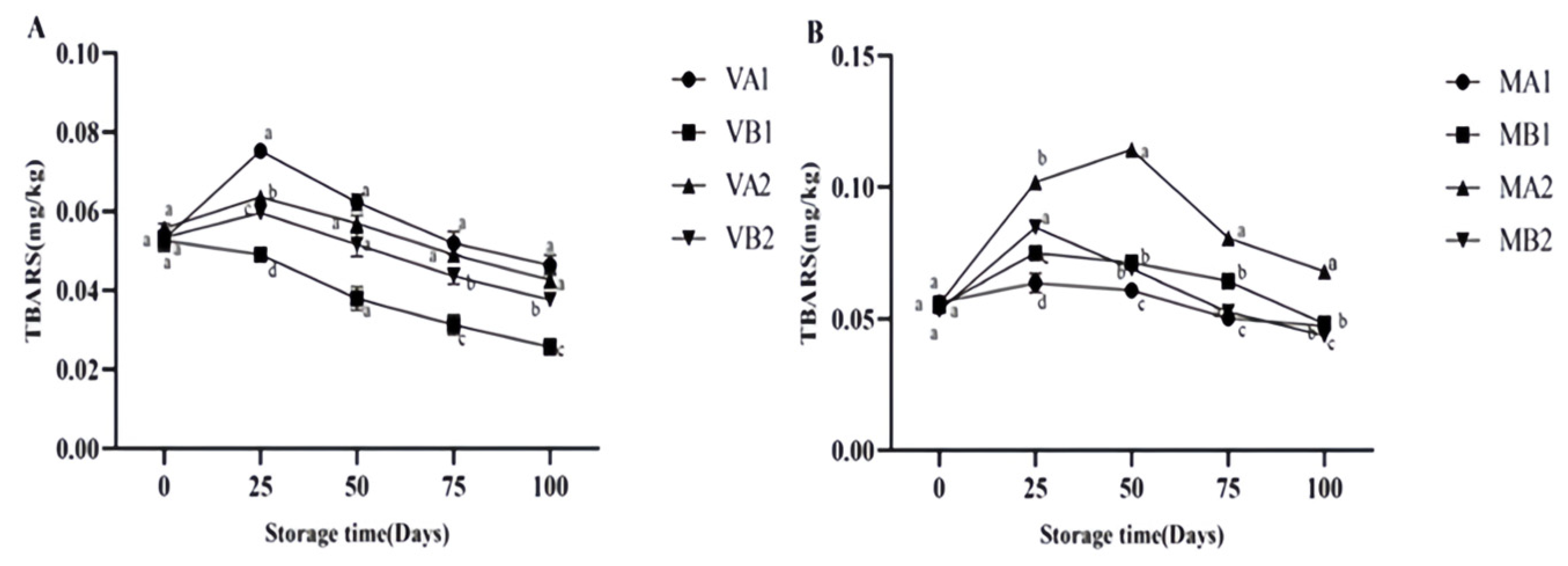
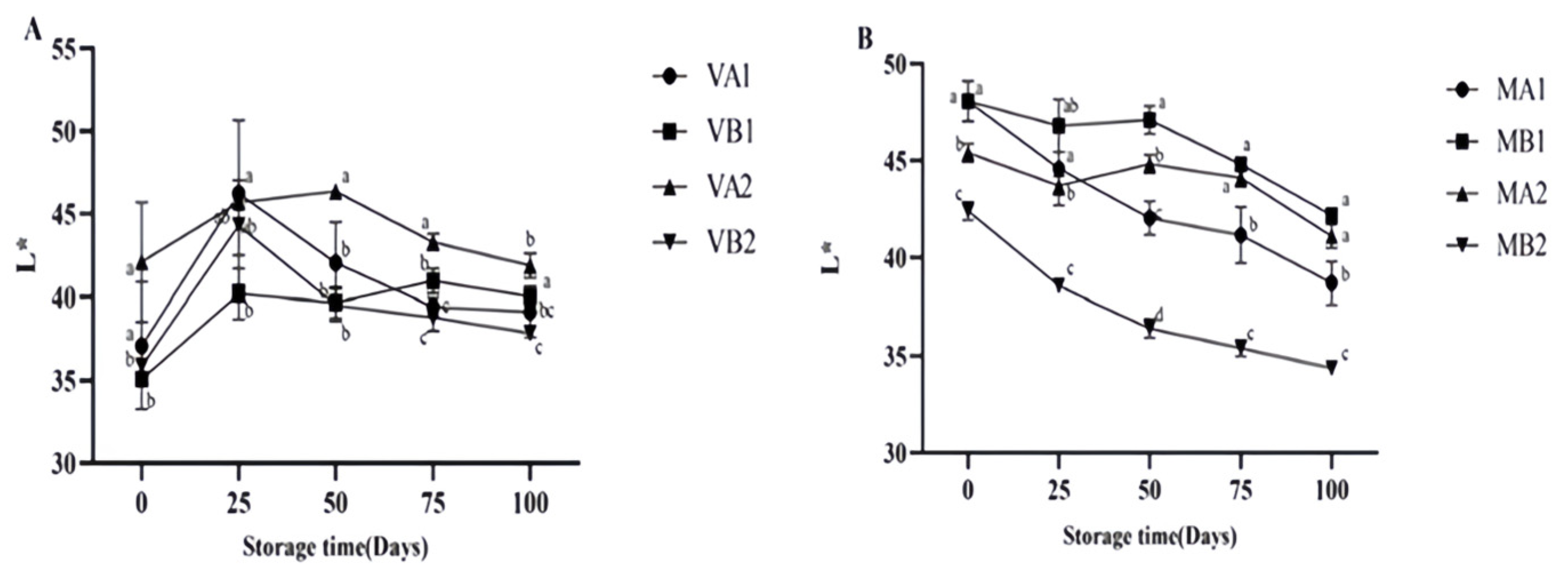
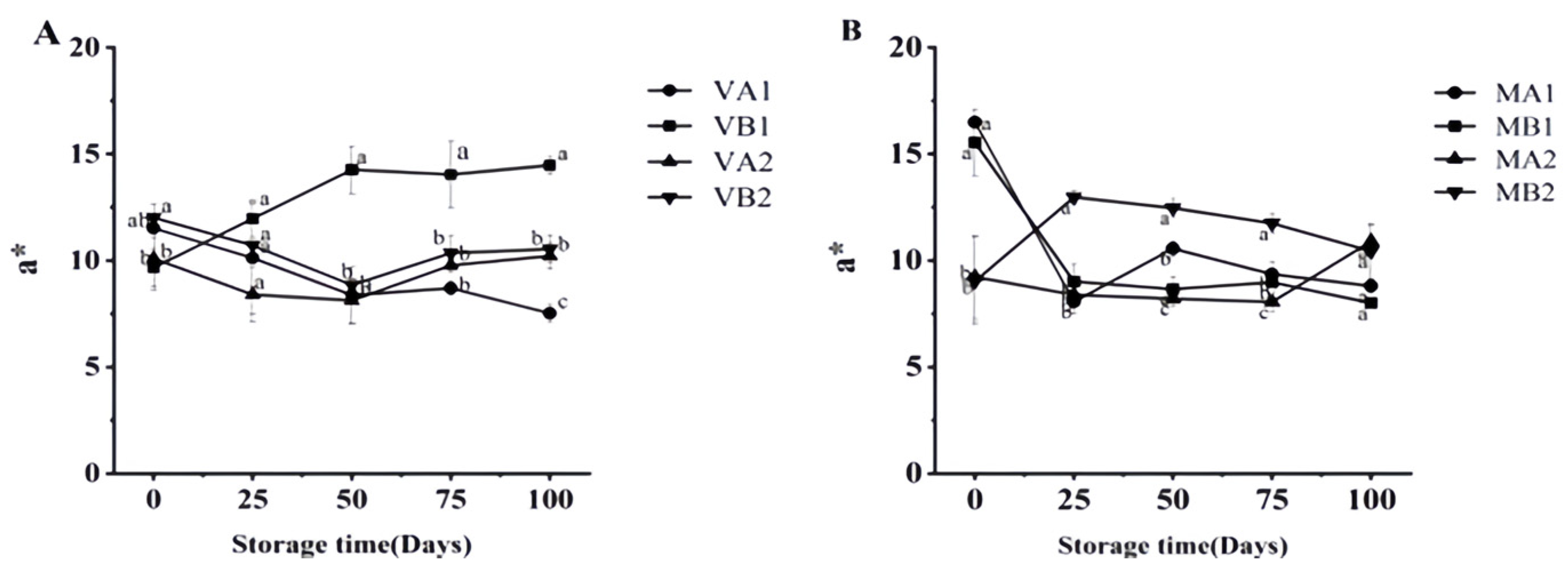
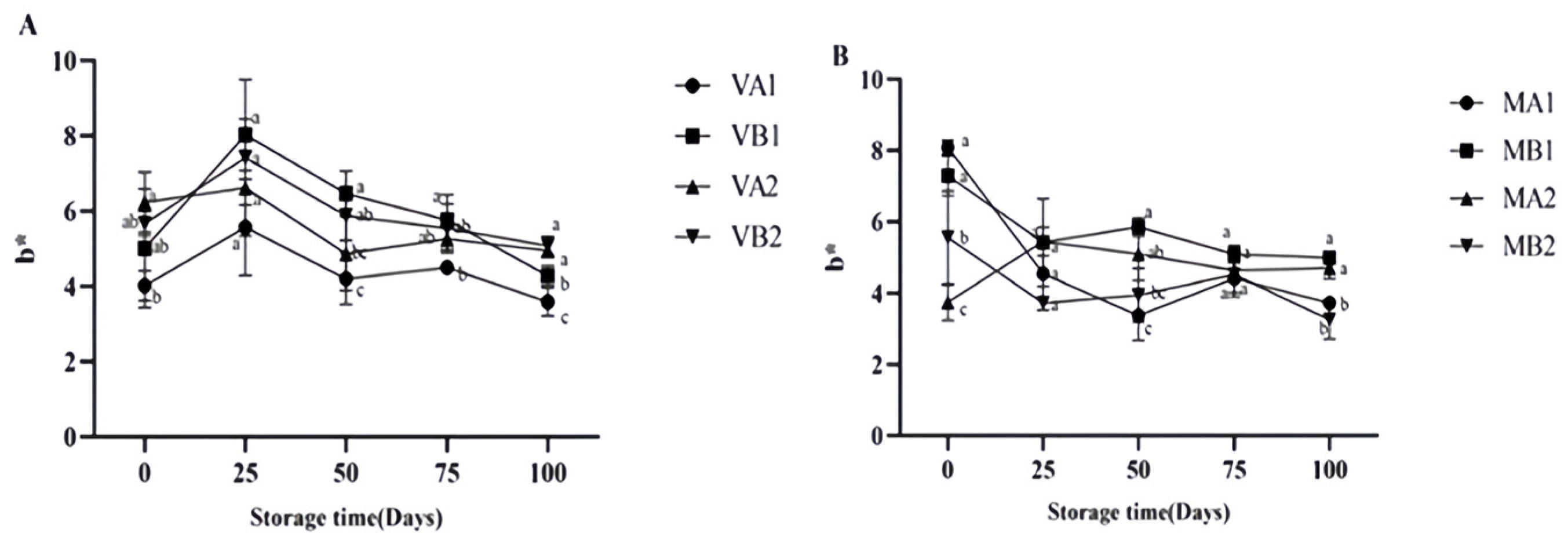

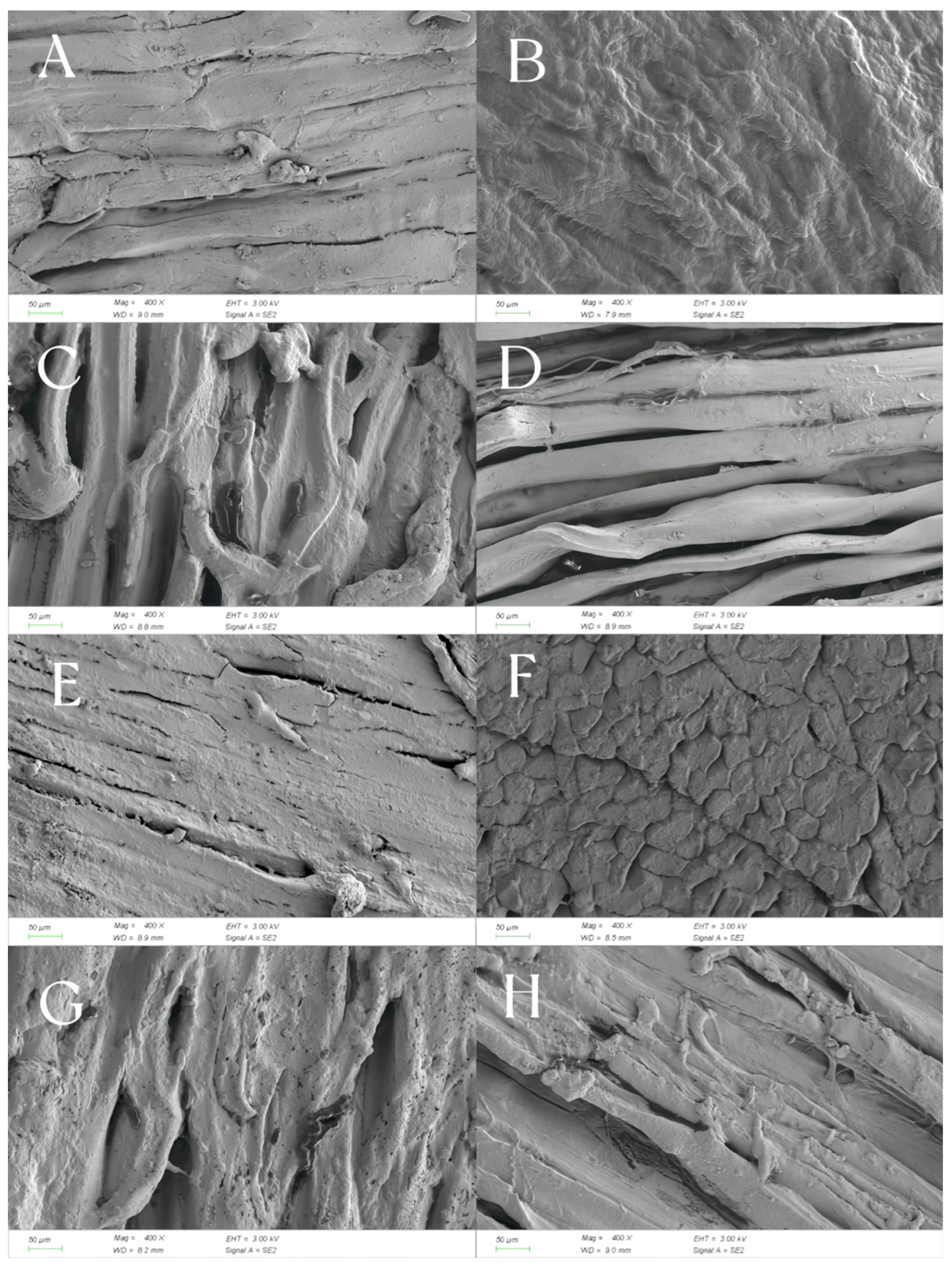
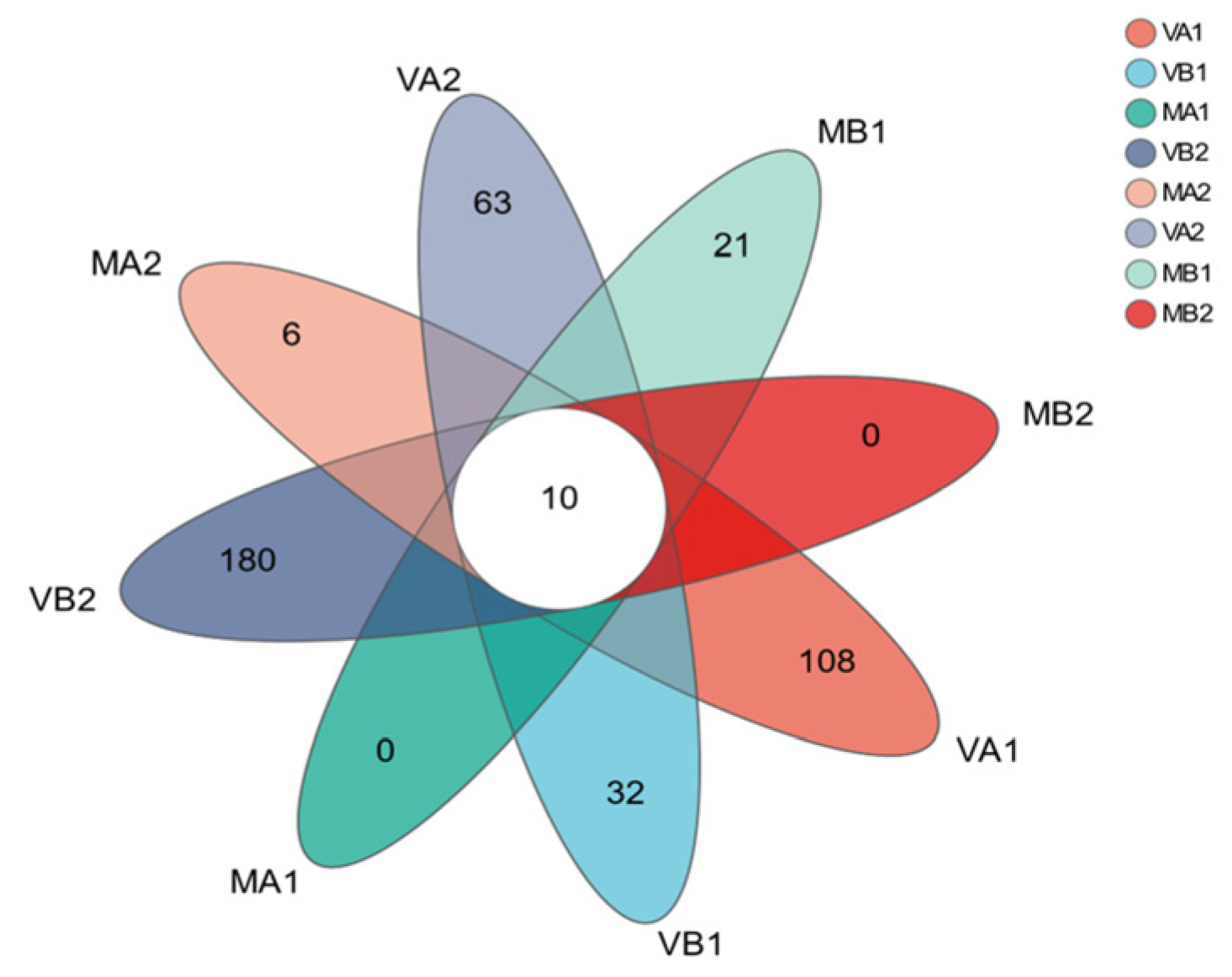
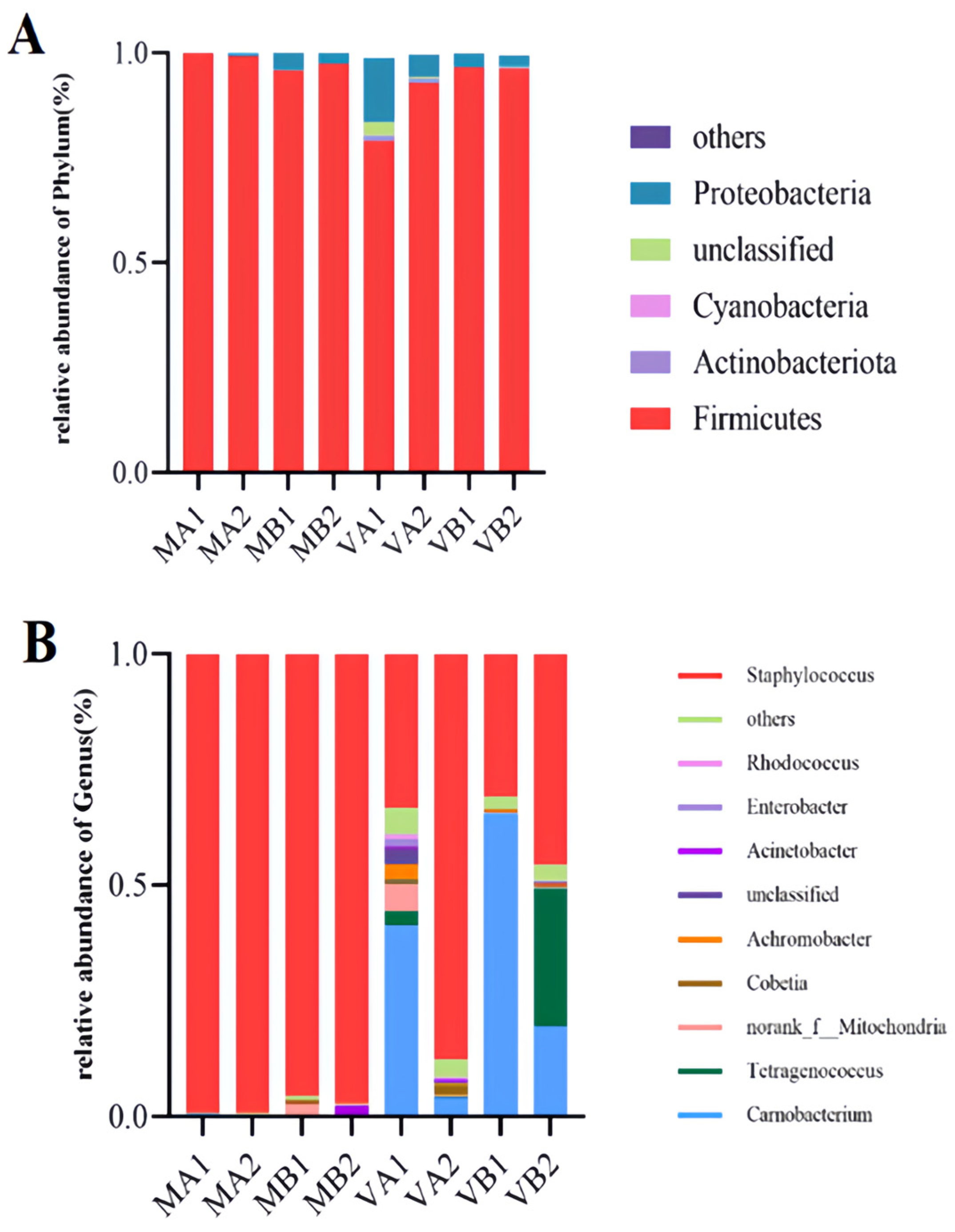
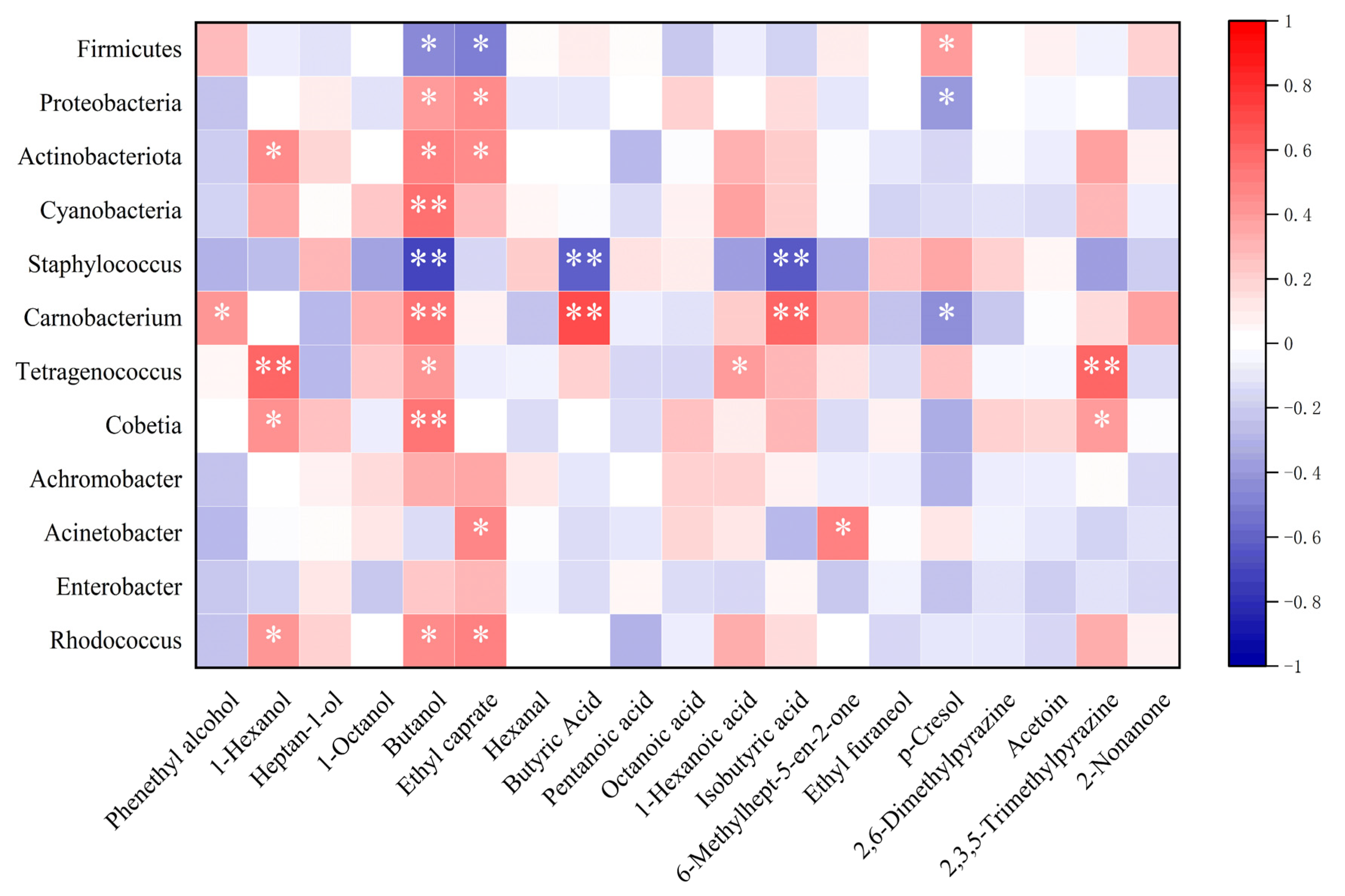
| Index | L* | a* | b* | Moisture Content | Aw | pH | TVC | TBARS |
|---|---|---|---|---|---|---|---|---|
| L* | 1 | |||||||
| a* | 0.129 | 1 | ||||||
| b* | 0.655 ** | 0.065 | 1 | |||||
| Moisture content | −0.655 ** | 0.169 | −0.265 | 1 | ||||
| Aw | −0.321 | −0.033 | 0.067 | 0.494 * | 1 | |||
| pH | 0.34 | 0.679 ** | 0.395 | −0.114 | −0.036 | 1 | ||
| TVC | −0.287 | −0.149 | 0.206 | 0.412 * | −0.031 | −0.08 | 1 | |
| TBARS | 0.216 | −0.726 ** | 0.071 | −0.136 | −0.307 | −0.646 ** | 0.216 | 1 |
| Compounds | OTV (μg/kg) | OAV Value (OAV ≥ 1) | |||||||
|---|---|---|---|---|---|---|---|---|---|
| VA1 | VA2 | VB1 | VB2 | MA1 | MA2 | MB1 | MB2 | ||
| Phenethyl alcohol | 0.045 | - | 156.12 | 458.32 | 215.61 | 194.00 | 47.67 | 249.52 | - |
| 1-Hexanol | 0.2 | 112.97 | 219.03 | 96.65 | 230.56 | 57.35 | 29.33 | 84.99 | 77.82 |
| Heptan-1-ol | 0.2 | 58.31 | 83.99 | - | - | 81.97 | 39.18 | - | 40.90 |
| 1-Octanol | 0.054 | 730.15 | 795.28 | 1252.72 | 999.66 | 729.45 | 394.49 | 194.49 | 1302.59 |
| Butanol | 0.5 | 306.16 | 299.56 | 266.57 | 291.30 | - | 12.34 | - | - |
| Hexanal | 0.21 | 643.75 | 531.36 | - | 299.79 | 1760.64 | 354.27 | 8.85 | 600.10 |
| Ethyl caprate | 0.02 | 501.64 | 35.76 | - | 12.14 | 20.60 | 20.14 | - | 372.28 |
| 6-Methylhept-5-en-2-one | 1 | 5.07 | 8.89 | 17.91 | 9.57 | 3.68 | 4.39 | - | 17.33 |
| Acetoin | 10 | 1.48 | 3.04 | 4.28 | 3.11 | 1.17 | - | 10.74 | 2.02 |
| 2-Nonanone | 0.05 | 83.03 | 761.11 | 1142.95 | 272.85 | 287.97 | 495.30 | 8.06 | 202.20 |
| Butyric Acid | 2.73 | 17.20 | 37.79 | 22.81 | 23.68 | 1.44 | 2.26 | 37.70 | 16.74 |
| Pentanoic acid | 0.5 | 4.51 | 3.60 | 4.70 | 2.49 | 7.25 | 4.86 | 6.09 | 3.67 |
| Octanoic acid | 5 | 1.72 | 1.29 | 1.34 | - | 1.45 | 0.95 | 3.73 | 2.12 |
| 1-Hexanoic acid | 1.5 | 13.97 | 17.30 | 16.35 | 15.86 | 11.85 | 5.21 | - | 16.41 |
| Isobutyric acid | 1 | 5.89 | 6.57 | 10.96 | 7.34 | 4.66 | - | 4.93 | - |
| Ethyl furaneol | 0.0025 | 511.64 | - | - | - | 146.58 | 84.74 | 8674.84 | 477.59 |
| P-cresol | 0.002 | - | 642.93 | 703.74 | 262.57 | 107.69 | 365.97 | - | 141.14 |
| 2,6-Dimethylpyrazine | 10 | 2.04 | 3.20 | 2.02 | 2.80 | - | - | 22.35 | 1.69 |
| 2,3,5-Trimethylpyrazine | 0.071 | 170.39 | 320.21 | 214.62 | 388.30 | - | 38.05 | 227.01 | - |
| Group | OUTs | Shannon Index | Simpson | Chao Index | Ace Index | Good’s Coverage |
|---|---|---|---|---|---|---|
| VA1 | 165.66 ± 8.50 | 1.84 ± 0.11 | 0.28 ± 0.02 | 174.97 ± 3.90 | 175.15 ± 8.56 | 0.99 ± 0.00 |
| VB1 | 102.66 ± 50.50 | 0.67 ± 0.19 | 0.69 ± 0.12 | 118.48 ± 53.97 | 118.87 ± 55.53 | 1.00 ± 0.00 |
| VA2 | 179.66 ± 28.71 | 1.29 ± 0.22 | 0.45 ± 0.06 | 215.98 ± 18.54 | 211.87 ± 20.28 | 0.99 ± 0.00 |
| VB2 | 245.66 ± 16.25 | 1.55 ± 0.20 | 0.32 ± 0.07 | 282.65 ± 18.45 | 283.65 ± 17.67 | 0.99 ± 0.00 |
| MA1 | 17 ± 3.60 | 0.05 ± 0.06 | 0.98 ± 0.02 | 25.62 ± 2.40 | 43.10 ± 16.15 | 0.99 ± 0.00 |
| MB1 | 62.66 ± 18.03 | 0.23 ± 0.21 | 0.92 ± 0.10 | 82.03 ± 32.41 | 89.49 ± 38.87 | 0.99 ± 0.00 |
| MA2 | 46.66 ± 6.80 | 0.07 ± 0.02 | 0.98 ± 0.00 | 67.39 ± 11.84 | 93.31 ± 31.60 | 0.99 ± 0.00 |
| MB2 | 245.66 ± 16.25 | 0.12 ± 0.19 | 0.95 ± 0.09 | 16.11 ± 9.17 | 16.60 ± 8.91 | 1.00 ± 0.00 |
Disclaimer/Publisher’s Note: The statements, opinions and data contained in all publications are solely those of the individual author(s) and contributor(s) and not of MDPI and/or the editor(s). MDPI and/or the editor(s) disclaim responsibility for any injury to people or property resulting from any ideas, methods, instructions or products referred to in the content. |
© 2025 by the authors. Licensee MDPI, Basel, Switzerland. This article is an open access article distributed under the terms and conditions of the Creative Commons Attribution (CC BY) license (https://creativecommons.org/licenses/by/4.0/).
Share and Cite
Chen, L.; Li, M.; Song, Y.; Wang, W.; Zhang, J.; Bai, T.; Gan, L.; Tang, C.; Ji, L. Impact of Packaging Methods on Physicochemical Properties, Flavor Profile, and Microbial Community in Low-Temperature Stored Mianning Ham. Foods 2025, 14, 2336. https://doi.org/10.3390/foods14132336
Chen L, Li M, Song Y, Wang W, Zhang J, Bai T, Gan L, Tang C, Ji L. Impact of Packaging Methods on Physicochemical Properties, Flavor Profile, and Microbial Community in Low-Temperature Stored Mianning Ham. Foods. 2025; 14(13):2336. https://doi.org/10.3390/foods14132336
Chicago/Turabian StyleChen, Lin, Mengdie Li, Yiting Song, Wei Wang, Jiamin Zhang, Ting Bai, Ling Gan, Congxia Tang, and Lili Ji. 2025. "Impact of Packaging Methods on Physicochemical Properties, Flavor Profile, and Microbial Community in Low-Temperature Stored Mianning Ham" Foods 14, no. 13: 2336. https://doi.org/10.3390/foods14132336
APA StyleChen, L., Li, M., Song, Y., Wang, W., Zhang, J., Bai, T., Gan, L., Tang, C., & Ji, L. (2025). Impact of Packaging Methods on Physicochemical Properties, Flavor Profile, and Microbial Community in Low-Temperature Stored Mianning Ham. Foods, 14(13), 2336. https://doi.org/10.3390/foods14132336






